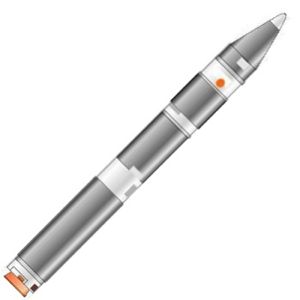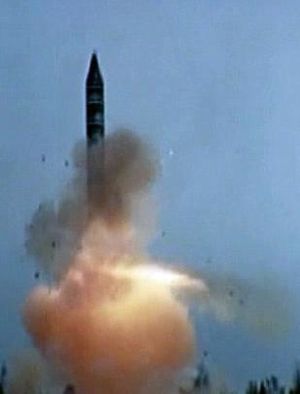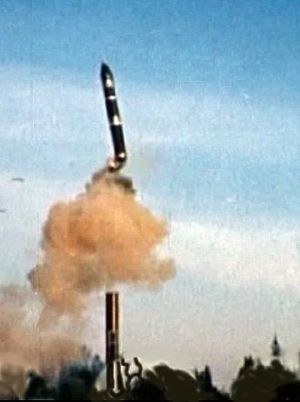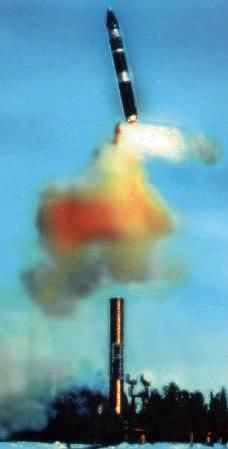
Home - Search - Browse - Alphabetic Index: 0- 1- 2- 3- 4- 5- 6- 7- 8- 9
A- B- C- D- E- F- G- H- I- J- K- L- M- N- O- P- Q- R- S- T- U- V- W- X- Y- Z
RT-23
 RT-23U |
Status: Retired 2003.
Development of a train-based ICBM had been a long-term objective of the Soviet military. Interest was already piqued by the V-2 launch train captured from Germany in 1945, and used at Kapustin Yar for the first ballistic missile tests in the late 1940's. The advantages were that they allowed a greater missile mass then road-mobile concepts. Yangel had studied a 12-wagon train-launched version of the R-12 in the 1950's, and this method had also been developed for the Burya intercontinental cruise missile of the same period. Difficulties in developing a road-mobile ICBM with a practical take-off mass led to studies of train-launched versions of the RT-2 and RT-21 in the 1960's. None of these went beyond the design stage.
Following study of the lessons learned in development of Yangel's abortive mixed propulsion land-mobile RT-20P, the leadership ordered long-term study by Yuzhnoye of a train-launched ICBM. This was to use all solid propellants and be of a practical size while delivering a large enough nuclear warhead to justify the expense. Long-term research on a train-based BZhRK version of the RT-23 began on 13 January 1969. The advanced project was completed the same year. KBSM designed the launch train, which would consist of six SM-SP-35 launch carriages, four carriages for storage and security of nuclear weapons, and five support carriages. In October 1975 the Pavlograd Mechanical Factory began fabrication of the key 15D65 high-performance solid rocket stage, the basis of the first stage of both the RT-23 ICBM and the R-39 SLBM.
Full development of the RT-23 mobile ICBM began with a resolution of 23 July 1976 which authorized development of both silo and mobile versions, with a total missile mass of 100 to 150 metric tons. The draft project for the single-warhead silo and truck-based versions was completed in March 1977. A 1 July 1979 decree added the requirement for the missile to be capable of dispensing 3 to 4 multiple independently-targeted warheads.
| RT-23 15Zh44 Ukrainian intercontinental ballistic missile. The draft project for the silo-based RT-23 with the 15F143 warhead was completed in December 1979. Trials of this basic version began at Plesetsk on 26 October 1982. The basic RT-23 was accepted for military service on 10 February 1983, but the decision was taken not to put it into production. All resources were to be devoted to an improved RT-23UTTKh. |
| RT-23 15Zh52 Ukrainian intercontinental ballistic missile. A draft project of the 15Zh52 MIRV train-based version of the RT-23 was completed in June 1980. The system was designed to allow the mobile launchers to conduct long-duration deployments up to 200 km from base. |
| RT-23 Tselina-2 Ukrainian intercontinental ballistic missile. |
| RT-23U 15Zh60 Ukrainian intercontinental ballistic missile. Design began of the silo-based version of the RT-23UTTKh on 9 August 1983. |
| RT-23U 15Zh61 Ukrainian intercontinental ballistic missile. A decree of 9 August 1982 ordered development of an improved RT-23UTTKh, dubbed 'Molodets'. Three basing modes were to be possible using a single containerized missile: train-launched, a 'Tselina-2' road-mobile transport, or silo-based. This would be able to deploy up to ten nuclear warheads from a layered circular dispenser. Retired in 2003. |
| Tselina-2 ICBM Ukrainian intercontinental ballistic missile. Development of the Tselina-2 road transport for a heavy ICBM can be traced back to the late 1960's. By the 1970's two versions had been designed, the 12-axle MAZ-7906 and 8-axle MAZ-7907. They could transport loads of up to 140 metric tons, much greater than the single-warhead RT-23 and its container. Although trials of prototypes were conducted in the 1980's, the road mobile version of the RT-23 was never put into service. |
Family: ICBM, train-launched. Country: Ukraine. Engines: RD-866. Stages: 15D305, 15D339, 15D206. Agency: Yuzhnoye. Bibliography: 2, 475, 476, 8556.
 | SS-24 Credit: Ukrainian Space Agency |
 | SS-24 Credit: Ukrainian Space Agency |
 | RT-23 |
Back to top of page
Home - Search - Browse - Alphabetic Index: 0- 1- 2- 3- 4- 5- 6- 7- 8- 9
A- B- C- D- E- F- G- H- I- J- K- L- M- N- O- P- Q- R- S- T- U- V- W- X- Y- Z
© 1997-2019 Mark Wade - Contact
© / Conditions for Use